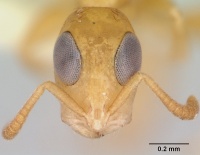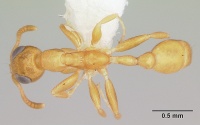Tetraponera parops
| Tetraponera parops | |
|---|---|

| |
| Scientific classification | |
| Kingdom: | Animalia |
| Phylum: | Arthropoda |
| Class: | Insecta |
| Order: | Hymenoptera |
| Family: | Formicidae |
| Subfamily: | Pseudomyrmecinae |
| Genus: | Tetraponera |
| Species group: | ambigua |
| Species: | T. parops |
| Binomial name | |
| Tetraponera parops Ward, 2006 | |
Tetraponera parops is known only from arid and semi-arid regions of east Africa (Kenya, Tanzania, Somalia). Colonies have been collected in dead twigs.
Identification
A member of the Tetraponera ambigua-group.
Ward (2006) - Workers of T. parops are similar to those of Tetraponera ophthalmica, but differ by the presence of abundant standing pilosity on the upper half of the head (CSC 12 - 22, compared with 2 - 4 in T. ophthalmica). The pilosity is particularly well developed at two roughened patches of cuticle on either side of the head near the posterior margin. These cuticular patches are absent in T. ophthalmica. The petiole of T. parops tends to be shorter, the eyes smaller, and the profemur more robust, compared with T. ophthalmica. In these respects T. parops workers are somewhat intermediate in morphology between T. ophthalmica and Tetraponera ambigua, although they are not likely to be confused with T. ambigua because workers of the latter species are larger and possess much more abundant mesosomal pilosity. The queens of T. parops can be distinguished from those of T. ophthalmica by the presence of a longitudinal line of roughened, punctate integument on the posterolateral corner of the head, flanking the ocellar triangle. Tetraponera parops queens also appear to have more robust petioles (PLI 0.59 - 0.64; n = 4) than those of T. ophthalmica (PLI 0.46 - 0.55; n = 5) but larger sample sizes might erase this distinction.
Keys including this Species
Distribution
Latitudinal Distribution Pattern
Latitudinal Range: -3.333333333° to -3.333333333°.
| North Temperate |
North Subtropical |
Tropical | South Subtropical |
South Temperate |
- Source: AntMaps
Distribution based on Regional Taxon Lists
Afrotropical Region: Kenya (type locality), Somalia, United Republic of Tanzania.
Distribution based on AntMaps
Distribution based on AntWeb specimens
Check data from AntWeb
Countries Occupied
| Number of countries occupied by this species based on AntWiki Regional Taxon Lists. In general, fewer countries occupied indicates a narrower range, while more countries indicates a more widespread species. |

|
Estimated Abundance
| Relative abundance based on number of AntMaps records per species (this species within the purple bar). Fewer records (to the left) indicates a less abundant/encountered species while more records (to the right) indicates more abundant/encountered species. |

|
Biology
Castes
Nomenclature
The following information is derived from Barry Bolton's Online Catalogue of the Ants of the World.
- parops. Tetraponera parops Ward, 2006: 126, figs. 8 10, 16 (w.q.m.) KENYA.
Unless otherwise noted the text for the remainder of this section is reported from the publication that includes the original description.
Description
Worker
Ward (2006) - (n = 10). HW 0.51 - 0.56, HL 0.73 - 0.84, LHT 0.46 - 0.51, CI 0.66 - 0.71, FCI 0.16 - 0.22, REL 0.42 - 0.47, REL2 0.63 - 0.68, SI 0.59 - 0.62, SI3 0.91 - 0.95, FI 0.44 - 0.52, PLI 0.54 - 0.61, PWI 0.42 - 0.47, LHT / HW 0.89 - 0.95, CSC 12 - 22, MSC 2 - 3.
Small species with elongate head; masticatory margin of mandible with four teeth; clypeus narrow and somewhat protruding anteromedially; median lobes of antennal sclerites expanded laterally and covering most of the antennal insertions; ocelli absent; profemur robust; pronotum laterally marginate but not strongly so; profile of mesosoma dorsum interrupted by raised metanotal spiracles; dorsal face of propodeum rounding insensibly into declivitous face; petiole as in Fig. 10; metabasitarsal sulcus absent. Integument finely coriarious/ puncticulate and sublucid, with roughened patches at posterolateral corners of head. Short standing pilosity common on head, especially at the posterolateral patches of coarser sculpture, elsewhere rather sparse; pronotum typically with a single pair of long setae, and one or two pairs of standing hairs present on petiole and postpetiole; scattered appressed pubescence on most of body, moderately dense on abdominal tergite 4 (hairs separated by less than their lengths). Pale yellow to yellowish-brown.
Type Material
Ward (2006) - Holotype worker. Kenya: 4 km NW Watamu, < 5 m (3º 20' S, 39º 59' E), 15.XII.1990, ex dead twig of Rhizophora, mangrove, leg. P.S. Ward, #11154, specimen code CASENT 0106133 (California Academy of Sciences). Paratypes. Series of workers, queens and one male, same locality and date as holotype, leg. P.S. Ward, # 11151, 11154, 11159, 11160-1 (The Natural History Museum, CASC, Museum of Comparative Zoology, NMKE, Philip S. Ward Collection, South African Museum, University of California, Davis).
Determination Clarifications
Ward (2006) - The species referred to as "Tetraponera ophthalmica" in Ward and Downie (2005: 326) is T. parops.
References
- Ward, P.S. 2006. The ant genus Tetraponera in the Afrotropical region: synopsis of species groups and revision of the T. ambigua-group. Myrmecologische Nachrichten 8: 119-130.
- Ward, P. S. 2022. The ant genus Tetraponera (Hymenoptera: Formicidae) in the Afrotropical region: taxonomic review and key to species. Zootaxa 5102 (1):1-70 (doi:10.11646/zootaxa.5102.1.1).
References based on Global Ant Biodiversity Informatics
- Garcia F.H., Wiesel E. and Fischer G. 2013.The Ants of Kenya (Hymenoptera: Formicidae)Faunal Overview, First Species Checklist, Bibliography, Accounts for All Genera, and Discussion on Taxonomy and Zoogeography. Journal of East African Natural History, 101(2): 127-222

